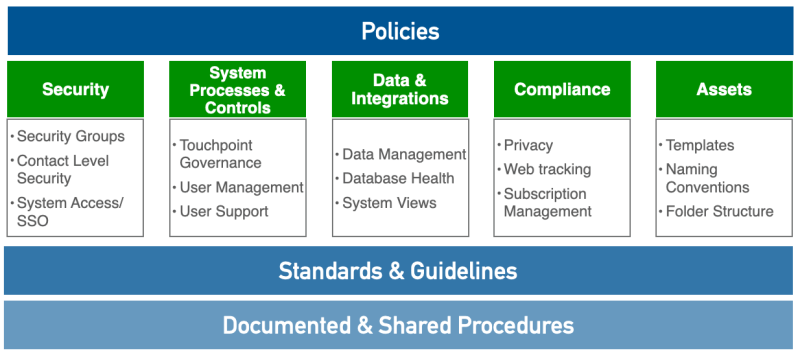5 Pillars of a Governance Framework
A strong governance framework is important for the health and security of any marketing automation platform, especially for organizations with global teams working in the same instance. While governance isn’t the most exciting topic, there are some critical areas that depend on having strong policies that are followed by all. These include:
- Data integrity to support targeting, personalization, and lead management
- Adherence to brand standards
- Privacy regulation compliance and reputation management
This list could be extensive, but it’s helpful to consider them in the context of a governance framework, which includes five core pillars for structural adherence.
Governance Framework Components
The governance framework consists of overarching marketing automation policies, broken down into five pillars: Security, System Processes & Controls, Data & Integrations, Compliance, and Assets. Each of these pillars has its own standards and guidelines that further outline specific practices end users follow along with the support and training provided by the governing body. As a best practice, all procedures, guidelines, and standards should be documented and shared in locations easily accessible to users.
Within each pillar, there are additional categories where governance procedures can be developed. These will vary based on the organization’s complexity and the governance framework’s maturity stage. To keep the marketing automation ecosystem running smoothly, the governance framework should be evaluated regularly to ensure that practices align with the business need, aid in efficient processes, and have a high adoption rate.
Managing the Governance Framework
You might be thinking, who is responsible for governance? For many global organizations, governance is a focal area of the Marketing Center of Excellence (CoE) due to its oversight of the larger marketing technology ecosystem and user base. (Alternatively, organizations that don’t leverage a CoE may have a Governance Board comprised of key stakeholders across marketing ops, sales ops, and platform admins who act in a similar capacity.) The CoE is responsible for creating governance standards based on best practices, and it provides support and training across the organization.
When developing the governance framework, the CoE will conduct organizational assessments, review processes and business requirements across teams and regions, identify pain points, and understand current user knowledge and experience within the platform. All of these insights come together to develop the governance policies as well as a broader change management plan that supports training and adoption within the organization. As organizations move from ad hoc governance into fully managed governance policies, the framework matures and there are less reactive measures to manage.
Looking for additional insights on creating a governance framework? Our blog posts outline the Six Keys to Successful Marketing Governance Programs and ways for Kick-Starting your Governance Plans. If your organization needs to develop or improve its governance framework, let us know. Relationship One is always here to help.
Thank you for subscribing!

